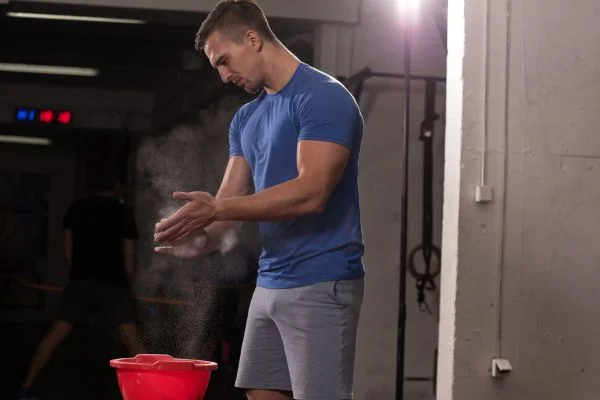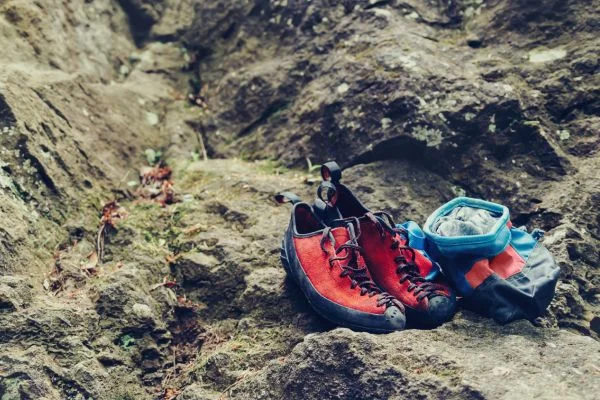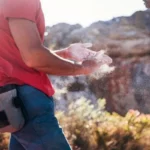If you’ve ever watched a climber scaling a wall, you’ve likely noticed the bright white dust that covers their hands. Of course, that’s chalk, which is a critical element of rock climbing gear. But what does climbing chalk do? Let’s find out!
What is Chalk?
Climbing chalk is precisely what it sounds like—a powdered magnesium carbonate used by climbers to keep their hands dry while scaling walls. It absorbs moisture from sweaty palms, allowing them to maintain a secure grip on the rock. This can be especially helpful in hot weather when sweat can make it difficult for even experienced climbers to keep their grip.
Chalk also provides climbers an extra layer of friction between their skin and the surface they’re gripping. This allows them to hold on for extended periods without fatiguing or slipping off their handholds. Plus, it’s easy to reapply whenever needed, so climbers don’t have to worry about running out of traction mid-climb.
Also Read: Does Climbing Chalk Contain Talc?
Types of Chalk
Loose Powder Chalk
Loose powder chalk is the most common type of rock climbing chalk. It’s made up of magnesium carbonate particles that absorb moisture and provide extra grip on holds. This chalk can be used alone or mixed with other ingredients, such as talc or arrowroot powder, to create a unique consistency and feel when applied.
One downside to this type of chalk is that it can get messy if users don’t have the proper technique when applying it or if they don’t have a suitable container for storing it.
Block Chalk
Block chalk has been around since the early days of climbing and is still popular today due to its convenience and portability. Because block chalk comes in chunks rather than powder form, it doesn’t leave as much residue on surfaces as the loose powder does.
In addition, block chalk can come in solid blocks or cubes that break apart easily, making them easy to store in pockets or packs without taking up too much space. This chalk also lasts longer than loose powder because users need less per application.
Liquid Chalk
Liquid chalk is relatively new but quickly becoming a favorite among climbers due to its correctly applied convenience and efficiency. Unlike traditional powders, liquid chalks are formulated with alcohol-based solutions that evaporate quickly after application, leaving behind only the active ingredients (typically magnesium carbonate).
This means climbers don’t need nearly as much liquid as traditional powders for optimal performance—plus, there’s no mess! Another bonus is that liquids are great for keeping sweaty hands dry for long climbs—make sure you apply enough before your ascent!
Also Read: Does Climbing Chalk Prevent Blisters?
What Does Climbing Chalk Do | When Should You Use It?

The best time to use climbing chalk is when your hands feel damp or sweaty—which can happen quickly when you’re nervous or just had a strenuous climb.
Applying chalk to your hands before embarking on a challenging route can give you more confidence and help keep your hands dry throughout the ascent. However, remember not to overdo it—too much chalk can be just as slippery as too little!
What Else Do You Need To Know?
Climbing chalk typically comes in either loose or block form; both work well, but each has its benefits and drawbacks. Loose chalk is easier to apply evenly across your entire hand but can slip out of pockets more easily than block form.
Block form can be more brutal to spread around but tends to stay inside pockets or pouches better than loose forms. Whichever type of chalk you choose, ensure you have enough on hand for your next climb!
Also Read: How Is Climbing Chalk Made?
Benefits Of Using Chalk
Chalk offers many advantages for climbers, including improved grip and better friction between the hands and the rocks or walls they are trying to climb.
Keeping your hands dry prevents slips while also improving grip strength. In addition, it helps reduce fatigue in your forearms because it reduces the energy needed to maintain a grip on specific holds.
Finally, it can make climbing more enjoyable because it reduces frustration when slipping off holds due to sweaty palms or slipping fingers due to lack of friction.
Using Chalk Properly
When using chalk, ensure you only use enough for what you need—don’t go overboard! Too much chalk can make gripping more difficult by creating a slippery film on your hands instead of helping them stay dry like intended.
Keep in mind that when applying chalk, apply only a tiny amount onto each hand instead of covering them entirely in powdery white dust! That way, you’ll still have enough left for future climbs without wasting excess chalk.
Also Read: Is Climbing Chalk Bad For The Environment?
Conclusion
In summary, The answer to the question What does climbing chalk do is that they serve an essential purpose in helping climbers maintain a secure grip as they scale walls and other surfaces.
Whether you opt for traditional loose powder or convenient liquid chalk will depend on your preferences as a climber; having some form of climbing chalk handy is sure to make your next climb more enjoyable and successful!



